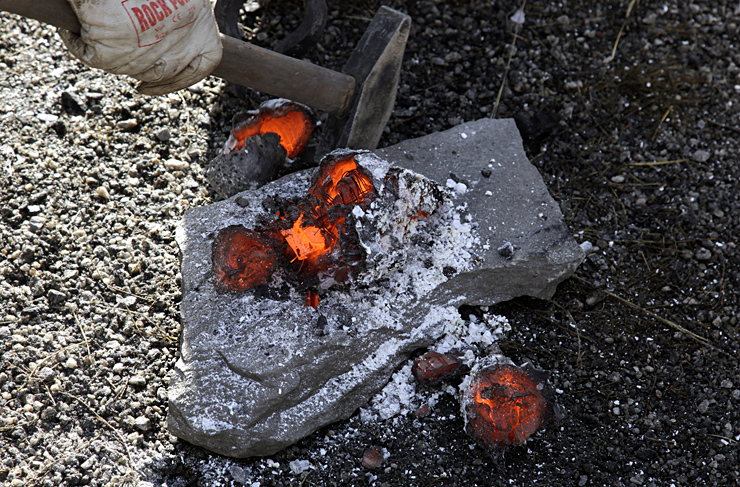Clay pack
The method involves forging the iron bar into a relatively thin band which is then loosely folded. A carbon-rich material is wound round the iron band before the whole thing is encased in clay. Once the clay pack is sufficiently dry, it is positioned in the forge where it is heated to 900–1000ºC. This temperature is maintained for at least one hour.
The reason why the iron is forged into thin bands, is to allow the gaseous carbon a larger metal surface to diffuse into. The deeper the migration, the slower the process. In practice, it is difficult to achieve migration beyond a couple of millimetres below the surface.
Having completed the carburising process, we forge welded the thin band back into a short, thick billet, to make it better suited for use as steel for the cutting edge.
Theophilus
We opted to use tanned goat skin and plant oils as our carbon-rich material. Goat skin and fat from an old pig were the ingredients used for the case hardening described by the monk Theophilus in c. 1120, in his textbook De diversis artibus (volume III, chap. 19). He describes the method in connection with the carburising and hardening of files (Hawthorne and Smith 1979:94-95):
In the same way you will also make very small files - square, round, half-round, three-cornered, and flat and thin. These are made from soft iron and you should harden them thus. When they have been cut with a hammer and chisel or a small knife, smear them with old pig fat and wrap them around with leather strips cut from goat skin and bind them with linen thread. After this cover them individually with kneaded clay, leaving the tangs bare. When they are dried, put them into the fire, blow vigorously, and the goat skin will be burnt. Hastily extract them from the clay and quench them evenly in water. Then take them out and dry them at the fire.
No clay pack
A variant of this carburising method is to heat the iron without the clay pack, in a part of the forge where all oxygen has been combusted and there is ample gaseous carbon. For example, the iron could be lying at the bottom of the coal pile, below the level of the air hole / tuyer (in a side-blown forge). Lee Sauder provides a good description of how this can be achieved in his article Quickie cementation (Sauder 2014).
Literature
- Hawthorne, J.G. og C.S. Smith (1979) Theophilus: On Divers Arts. University of Chicago Press, 1963; reprinted New York: Dover Publications 1979.
- Sauder, Lee (2014) Quickie cementation (09.05.2016).




















































